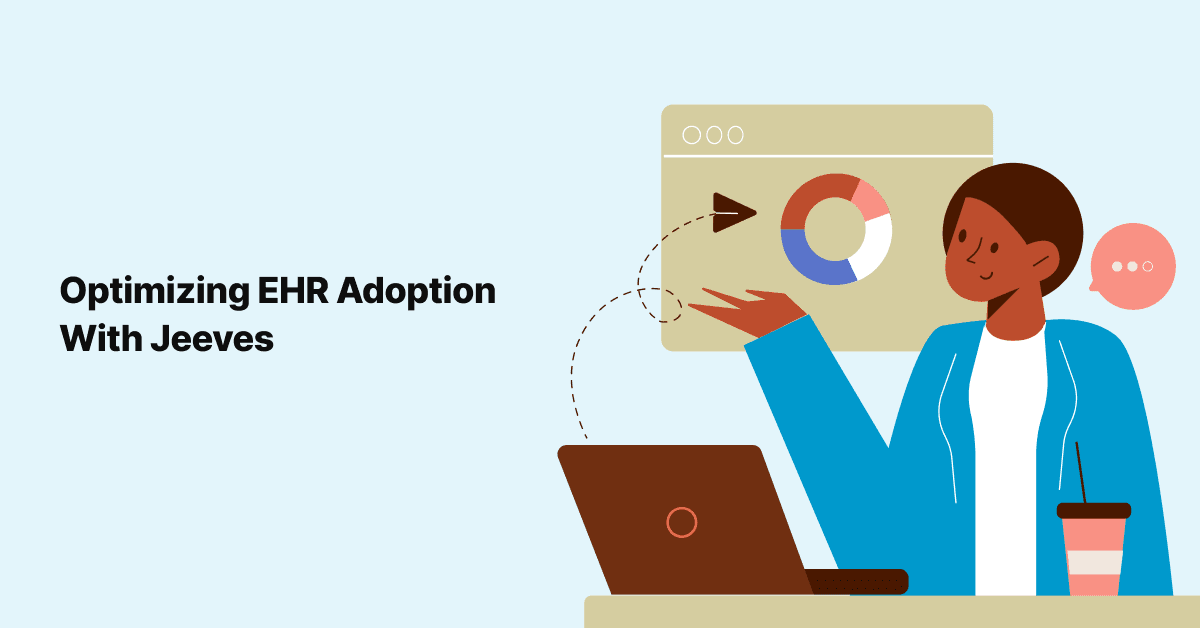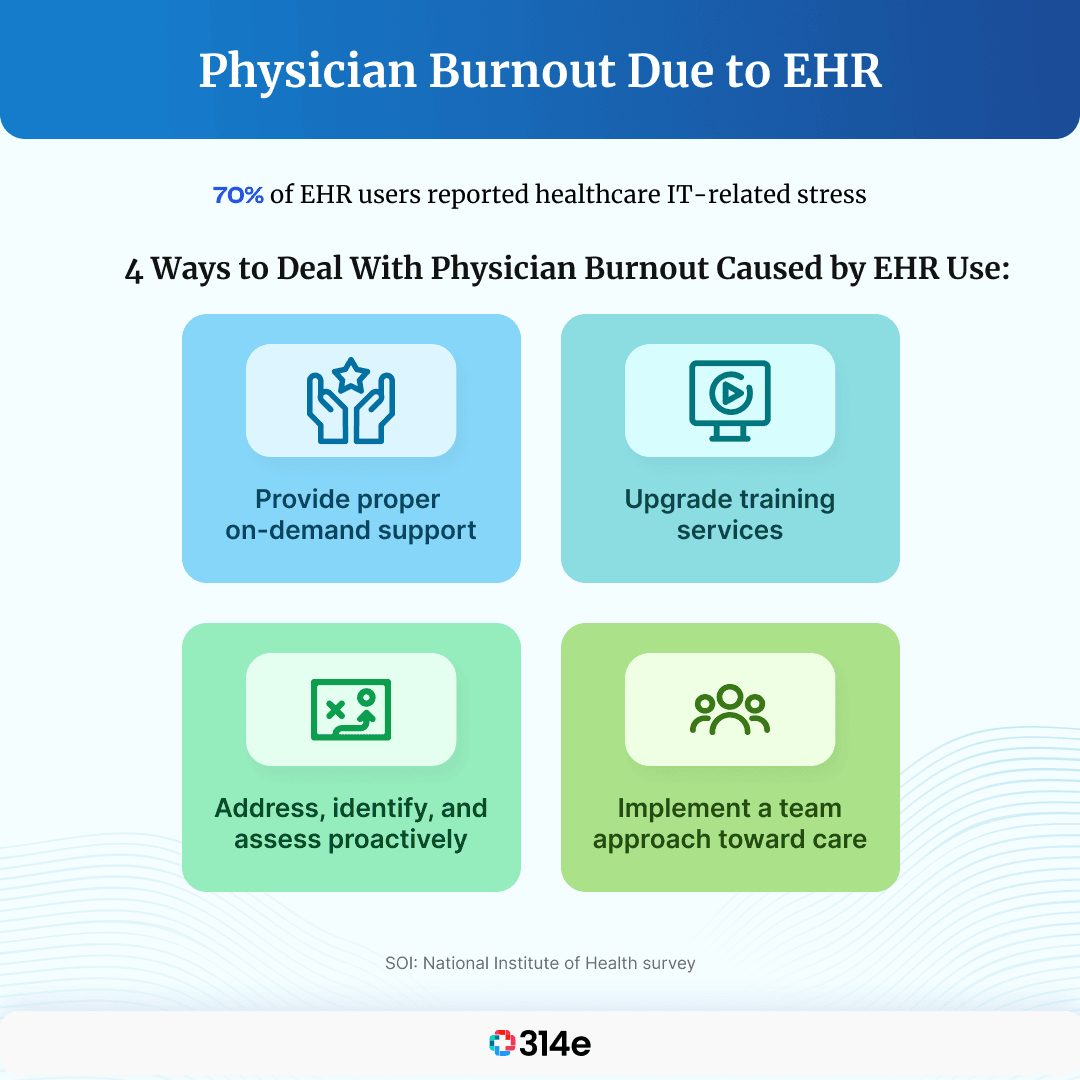
Optimizing EHR Adoption With Jeeves
Over the past few years, the healthcare industry has seen a lot of development in terms of technology. …

According to a healthcare research, “Four out of five physicians say they are burned out right now.”
For quite some time now, there has been a common epidemic that is spreading across the healthcare industry of the United States. This epidemic is commonly referred to as Physician Burnout. It apparently has a very pervasive and negative effect across all aspects of medical care.
In this blog, you will be able to explore:
Physician Burnout could be defined as a long-term reaction to stress that could be characterized by depersonalization. It can often lead to emotional exhaustion and a feeling of decreased personal achievement among physicians. This disorder could turn fatal and is not just bad for the doctors but also for their families, the staff, the patients they are dealing with, as well as the organization they are working for.
According to a survey, it has been found that there are three most cited factors associated with Physician Burnout. They are - insufficient documentation time, high inbox volumes of messages, and negative EHR perceptions. Usually, most of the time, physicians are happy with their choice of career, but it is estimated that this field has higher burnout risks than other fields.
In 2009, the Health Information Technology for Economic and Clinical Health Act encouraged the adoption of Electronic Health Records (EHRs) within hospitals with the intention of improving the quality, efficiency, and healthcare outcomes. This was followed by the large-scale adoption of EHRs in US hospitals. Reportedly, 96% of acute care non-federal hospitals and 86% of office-based physician hospitals started using EHRs between 2015 and 2017.
The presence of EHR has been found to create significant cognitive and clerical burdens among physicians. The high demand for EHR documentation gets carried over to the personal time of the providers. Physicians began spending 1-2 hours on desk work and EHRs for every direct interaction with patients. Along with that, they spent an additional 1-2 hours of their personal time involved in EHR-based activities daily outside the office hours. Slowly and steadily, this led to professional dissatisfaction among physicians, with burnout being a direct outcome.
The general symptoms of Physician Burnout involve:
Physician Burnout is linked directly with a number of undesirable consequences. These include:
A challenge in dealing with Physician Burnout is that the current solutions fail to provide instant help to the physicians. Take tip sheets, for instance; the entire procedure of tip sheet documentation could turn out to be very onerous. Whether it’s creating a new one, updating an existing one, or even searching through various tip sheets - it takes up a lot of time and effort, making this process cumbersome. Helpdesks, on the other hand, take forever to provide the required solution. Clinicians have historically depended on Service Desks to provide application support. However, due to time pressures and several issues routing to different agents on different occasions, not to mention the high costs, they bring in their own set of inherent problems making the tasks more difficult for the physicians rather than making them easier.
Many hospitals have implemented human At-the-elbow (ATE) or Go-live support for tackling temporary surges in upgrade issues or new implementations. While initially, it was a great hit among clinicians, considering that it provided literal At-the-elbow support to them, it also had its own drawbacks. The human ATE support system usually had the capacity of solving 3 to 5 issues per day while remaining idle the rest of the time, which meant that it could not be around forever and, therefore, with time, must be tapered down. The tapering down again led to the problem of withdrawal symptoms. As soon as the ATE support started being tapered, the complaints of the clinicians shot up, and productivity went down. Moreover, the cost of these ATE support experts were exorbitant. All of these eventually added up to the burden of the physicians.
The reluctance of the physicians to talk about this issue also imposes a lot of challenges in terms of dealing with it. It stops them from asking for help when they need it the most. Also, physicians have a hard time identifying themselves as patients. Some of the respondents from previous surveys have noted that physicians do not easily accept therapeutic strategies for their disorders. Also, most of the time, physicians want to represent their professional identity as being enduring and selfless. Hence, discussing their own issues and disorders with others would stop them from living up to their own image.

One of the first steps of managing a Physician Burnout would be to recognize and measure it. This involves timely measurement of the physician’s well-being, assessing them proactively, and mitigating all the regulatory burden on them. Once the burnout has been identified and measured, it is important to take the initiative to address it.
Providing proper on-demand support is an effective way through which the stress level being burdened on the physicians could be managed. Implementing the correct Healthcare Digital Adoption Platform (DAP) is important. A Healthcare DAP should be able to provide the right in-application, in-workflow support for various hospital applications. The key benefits of implementing the correct Healthcare DAP is that it would:
All of these would lead to the reduction of EHR fatigue which would ultimately help in reducing Physician Burnout.
Upgrading the training services is another way to manage Physician Burnout. It has been found that knowledge retention through classroom training is often low and not very effective. In that case, it is important that classroom training is upgraded to interactive e-learning and microlearning methods to improve knowledge retention efficiency. Microlearning videos are, in fact, ideal for agile training deployment and development. Microlearning videos are immersive and engaging and have the potential to offer high recall value as they are specifically focused on achieving a certain learning outcome in a particular amount of time. Also, additionally, they are comparatively less expensive to develop, all of which leads to better RoI.
A team approach to care could also help in decreasing Physician Burnout. Through this approach, it is easier to focus on offloading the burdens linked with clerical tasks like inbox management, documentation, nonphysician entry of the order, care coordination, and health coaching to the medical assistants, specialty technicians, or nurses.
One must remember that it might not be possible to entirely eliminate Physician Burnout. However, it is possible to tone it down by addressing the common causes strategically. But most importantly, it is important to remove the taboo regarding discussing this issue publicly. Once the stigma around it is resolved, only then can there be hopes of tackling the issue by addressing the other relevant factors and eventually getting rid of this syndrome.
Join over 3,200 subscribers and keep up-to-date with the latest innovations & best practices in Healthcare IT.

Over the past few years, the healthcare industry has seen a lot of development in terms of technology. …

We’ve previously shared some tips for delivering the best Epic training in the healthcare IT space, but as the …

It’s no surprise that the roster for any given Epic implementation team is largely project and technical savvy …